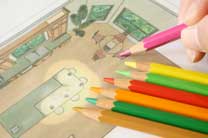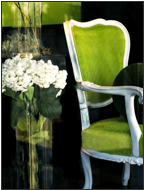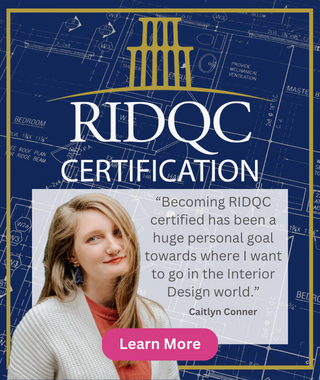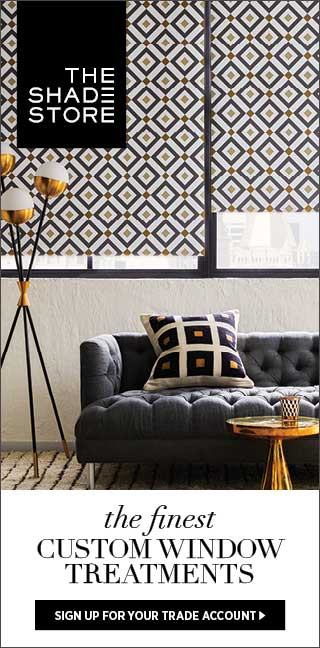DSA Newsletter - November, 2009
Notes from Natasha
Wouldn't you love a three day, two night getaway?
How about an opportunity to network with other interior
design professionals? Could your business benefit from shared ideas and
resources found among like minds? This could be your chance!
 Designer Society of America wants to host just such an event in Orlando,
Florida in April 2010. We recognize how crucial it is, especially in
today's trying economy, to come together to brainstorm and share ideas
and concepts amongst designers across the county.
Designer Society of America wants to host just such an event in Orlando,
Florida in April 2010. We recognize how crucial it is, especially in
today's trying economy, to come together to brainstorm and share ideas
and concepts amongst designers across the county.
The event will feature some of the top speakers in our industry,
sharing information on topics such as operating a successful design
business, industry trends and important legislative issues that directly
affect the way you practice your trade. The more designers that commit
to the event, the deeper the discount available for each of our members.
In fact, getting onboard this early in the game will allow you to have
input regarding the overall schedule for the event.
Interested?
Contact me today and tell me how you rate the importance of issues and
information such as marketing, networking, sharing information, feng
shui, etc. In addition, you can still specify preferred dates for the
end of April and we will plan the gathering based on the opinion of the
majority. This is what DSA is all about!
 If they have any topics you would like to share or suggestions for the event, please e-mail me at info@dsasociety.org
Please put "Attention Natasha" in the subject line. We hope to see you in Orlando!
If they have any topics you would like to share or suggestions for the event, please e-mail me at info@dsasociety.org
Please put "Attention Natasha" in the subject line. We hope to see you in Orlando!
Warmest regards,
Natasha Lima Younts
Founder
Designer Society of America
Member Spotlight
Faith Rosenthal
Long Island Design Center
Long Island,NY
 As the founder of Long Island Design Center, Faith Rosenthal brings her clients the benefit of more than two decades of hands-on experience in construction, remodeling and renovation. She is an expert in CAD (computer-aided design), and before graduating from the Metropolitan School of Interior Design, earned a Bachelor of Science degree from the University of Hartford.
As the founder of Long Island Design Center, Faith Rosenthal brings her clients the benefit of more than two decades of hands-on experience in construction, remodeling and renovation. She is an expert in CAD (computer-aided design), and before graduating from the Metropolitan School of Interior Design, earned a Bachelor of Science degree from the University of Hartford.
Long Island Design Center has been serving residential and commercial clients throughout Long Island, New York City and Westchester for over 20 years. A full-service interior design firm, LIDC has extensive experience in project management and has its own dedicated contracting team. LIDC coordinates with all of the involved design professionals and provides on-site supervision through every stage of construction.
 LIDC frequently works with space planners, as well as designers, and specializes in assessing architectural plans to make sure that they address the practical, day-to-day needs of their clients' lifestyles. In addition to consulting on furniture, fabrics, fixtures and accessories, Faith and her crew handle the installation of home theatre, home entertainment and whole-house acoustical systems. Their extensive knowledge of code requirements ensures the smooth completion of each project.
LIDC frequently works with space planners, as well as designers, and specializes in assessing architectural plans to make sure that they address the practical, day-to-day needs of their clients' lifestyles. In addition to consulting on furniture, fabrics, fixtures and accessories, Faith and her crew handle the installation of home theatre, home entertainment and whole-house acoustical systems. Their extensive knowledge of code requirements ensures the smooth completion of each project.
For more information about Faith Rosenthal and Long Island Design Center, visit their brand new website at www.lidcinc.com
To The Design Trade Only
 To The Design Trade Only had a very successful High Point market trip and has posted some of our favorite finds for sale on our Featured and Sales Items page.
To The Design Trade Only had a very successful High Point market trip and has posted some of our favorite finds for sale on our Featured and Sales Items page.
We are also pleased to announce our new upholstery program. We will manufacturer any style of COM upholstery at huge savings and welcome your requests for quotes along with a photo and dimensions.
Now, the elegant and upscale lines of upholstery that designers covet are available at affordable pricing. WWW.TOTHEDESIGNTRADEONLY.COM
Contact Mindy@tothedesigntradeonly.com for additional information and quotes.

Well-Designed Websites Critical
By Tony Estrada  In today's financial climate, tightening up one's marketing plan should be paramount on every small business's list of priorities, and a well-designed website is the cornerstone of every modern marketing plan. My company, tonyontheweb.com, is now offering Designer Society of America members special pricing, making having your own website more affordable than ever. At tonyontheweb.com, we understand the special needs of designers and have built over 400 websites to date. We have the experience to bring your vision to life!
In today's financial climate, tightening up one's marketing plan should be paramount on every small business's list of priorities, and a well-designed website is the cornerstone of every modern marketing plan. My company, tonyontheweb.com, is now offering Designer Society of America members special pricing, making having your own website more affordable than ever. At tonyontheweb.com, we understand the special needs of designers and have built over 400 websites to date. We have the experience to bring your vision to life!
Here are a few tips to help you design the website you want:
Define your target audience. If your design business specializes in clean modern design, your website probably shouldn't feature images of lushly layered interiors thick with antiques, unless that's a new market you're trying to break into. Presenting yourself in an accurate light saves a lot of wasted time on the potential client's part, as well as your own.
Photograph your work. I cannot tell you how many clients come to me with a photo ripped out of a magazine and a Polaroid picture! We all know that getting back into a client's home or business after the project is completed is next to impossible. One way to avoid this inconvenience is to work photography into your process. It's always preferable to have your work professionally photographed, but at the very least take digital photographs yourself. I've had wonderful results using creative cropping and mildly enhancing personal photographs using Photoshop. Digital cameras today are compact; most will slip into a purse or briefcase and produce excellent quality photographs!
Surf the web. A good web designer is a skilled listener. He or she will listen to your ideas and build you a winning website. In order to crystallize your ideas on how you want your website to look and function, surf the web. Inspiration can come from several different sources, as well as several different types of websites. If you see a button rollover on a hardware website, it can be combined with a page transition from a fashion website and a contact form from a movie theater website. The clearer your vision is, the smoother the process will be.
Do your homework. Choosing a web designer can be a challenge. A good place to start would be speaking with your peers who already have websites. Ask them who built their sites and what the experience was like. While surfing the web, many websites will have a link hidden in a corner "site by Joe Smoe." If you like how the website functions, follow the link. If there is no credit listed on the site and you really like the website, call or email the business or individual and ask them who built it. Most people who have had a positive experience with a web designer will be more than happy to give you the designer's contact information.
Building a website is an incredibly creative and exciting experience. Follow the tips listed in this article and you will have a website you can be proud of. Websites are no longer a novelty, they are a necessity. A professionally designed website will put you and your business head and shoulders above your competition.
Tony Estrada is the founder of tonyontheweb.com, a boutique web design company, specializing in web design for the creative professional.
For more information:
www.tonyontheweb.com
tony@tonyontheweb.com
(323) 653-8669
NKBA News

Registration for KBIS 2010 is Now Open
 The Kitchen & Bath Industry Show is coming to Chicago from April 14 to 18, 2010. Inspiration, information, connections and education are there for the taking at one monumental industry event. Design your KBIS experience by following the easy-to-navigate knowledge paths in the redeveloped conference program. Take a look at the exciting lineup of industry leaders exhibiting innovative products at Chicago's McCormick Place this spring. Visit KBIS.com to register and to find an overview of the sessions, seminars, courses and presentations that will help you maintain a strong foundation for the success of your business.
The Kitchen & Bath Industry Show is coming to Chicago from April 14 to 18, 2010. Inspiration, information, connections and education are there for the taking at one monumental industry event. Design your KBIS experience by following the easy-to-navigate knowledge paths in the redeveloped conference program. Take a look at the exciting lineup of industry leaders exhibiting innovative products at Chicago's McCormick Place this spring. Visit KBIS.com to register and to find an overview of the sessions, seminars, courses and presentations that will help you maintain a strong foundation for the success of your business.
Success Strategies:
3 Simple & Quick Ways to Recharge Every Day
© www.melissagalt.com
Do you ever just run out of steam when you are working? I do! Do you get project block or feel stuck or stalled? I do! I've learned that the quickest and simplest ways to recharge my productivity and my creativity are:
Change the Scenery
 This can be as easy as getting outdoors for a 15 minute walk. Take time to relax in your garden, on your deck, or looking out your balcony. When getting outside isn't an option, even just moving to a different room in the house (when you have a home office), or spending a few minutes in the company break room can be all you need to jumpstart again.
This can be as easy as getting outdoors for a 15 minute walk. Take time to relax in your garden, on your deck, or looking out your balcony. When getting outside isn't an option, even just moving to a different room in the house (when you have a home office), or spending a few minutes in the company break room can be all you need to jumpstart again.
Change the Sounds
When you listen to the radio all day, turn it off for a few minutes and listen to the quiet. On the other hand, if you usually work in silence, take music or even a news break (that can prove stressful!). The key here is to change whatever routine you are used to, even for just 15 minutes, so that you break the pattern you are in and break out of being stuck or stale.
Change the Touch
 Many of us today are on our computers so much that we forget the lost art of communicating by phone. Text has become a replacement for voice to voice talk. Change your routine! When you are used to tapping a keyboard, whether laptop or palmtop, stop and instead choose to make a phone call or two. Now this doesn't have to be a license to dive into calling your best friend for two hours, but instead could be short business calls, vendor follow ups or 10 minutes with a colleague or friend. The point is to change your mode of communication, shift the way you touch others, even for a few minutes.
Many of us today are on our computers so much that we forget the lost art of communicating by phone. Text has become a replacement for voice to voice talk. Change your routine! When you are used to tapping a keyboard, whether laptop or palmtop, stop and instead choose to make a phone call or two. Now this doesn't have to be a license to dive into calling your best friend for two hours, but instead could be short business calls, vendor follow ups or 10 minutes with a colleague or friend. The point is to change your mode of communication, shift the way you touch others, even for a few minutes.
Small changes can have powerful results. It is easy to get stuck in a mindless routine that leaves you feeling drained and not nearly as productive. Whether you work out of your home, hotel rooms (road warriors), or a company office, pay attention to ways you can break the pattern to boost your productivity.
For more great productivity tips geared to the success of small business owners and solopreneurs, be sure to check out www.todaybydesign.com. And when you are ready to take your business to the next level, get your free business makeover in 20 minutes at www.sixfigureprofessionals.com.
Fearless Color
By Kate Smith and Kiki Titterud
 It's frustrating when you come up with a perfectly beautiful scheme only to have the client hesitate with your design because they are apprehensive about the colors you've selected. Designers who recognize that one of the client's biggest fears is choosing color will know the importance of successfully selling their color choices to the client. To do this you not only need to have confidence in your own ability to use color, but also possess the skills to pass that confidence on to your clients through explanations and examples.
It's frustrating when you come up with a perfectly beautiful scheme only to have the client hesitate with your design because they are apprehensive about the colors you've selected. Designers who recognize that one of the client's biggest fears is choosing color will know the importance of successfully selling their color choices to the client. To do this you not only need to have confidence in your own ability to use color, but also possess the skills to pass that confidence on to your clients through explanations and examples.
An experienced designer talks to their clients about how the various components of color work together and why color harmony is important to a well-designed room. They are able to do this because they have gained a solid understanding of the basics of color through a combination of education and experience.
While most designers possess some natural ability, developing knowledge of color history, terminology and the color wheel is essential for every designer. Recognizing the importance of color gives you the ability to successfully create harmonious spaces every time. Bringing together an understanding of color theory and color harmony with the basics of color psychology, the meanings and association of the colors, gives you a powerful tool to effectively create spaces that evoke mood or emotion.
Honing your skills and expertise will allow you to unlock the secrets to creating color schemes that are aesthetically appealing and give you the ability to confidently explain why your choices are the perfect solution for the client's space. When you can give your client the reasons for your choices and show how the colors you have chosen express their personality and accentuate their interior space, you greatly improve your chances of having your ideas readily accepted.


Kate Smith, CMG, CfYH, DSA and Kiki Titterud, Allied ASID, CMG, CfYH, DSA are both recognized authorities on color and train design professionals across the US through the accredited Color for Your
Feng Shui Tips
from Mary Dennis
Executive Director
School of Graceful Lifestyles
Feng Shui Designer & Educator
Last month as we continued on our quest to bring feng shui to your living rooms, we left you "marrying up the room," with sofa pillows and drapery accents to complement your chosen color palette. Let's begin this time with creating a conversation area by connecting other pieces, such as a cocktail table and chair to the sofa. This begins to form a circle that lends to the feeling of community.
This conversation area should be no more than 12-14 square feet, as more distance between seating will make the occupants feel unconnected to each other. Be mindful to place your seating within a comfort able "cross your leg distance" from the cocktail table. This could change according to the height of the family members, but you can always be safe with the 26-inch standard.
 Your seating in any size living room should be a minimum of six seats: Sofa, two chairs and an ottoman provide the easiest and most flexible solution for redesigning a living room. The ottoman can always go in front of the fireplace, entertainment center or television because of its low seating and armless design. End tables are used as connectors and do well between two chairs or between a sofa and one chair or loveseat.
Your seating in any size living room should be a minimum of six seats: Sofa, two chairs and an ottoman provide the easiest and most flexible solution for redesigning a living room. The ottoman can always go in front of the fireplace, entertainment center or television because of its low seating and armless design. End tables are used as connectors and do well between two chairs or between a sofa and one chair or loveseat.
A chair placed without a wall as a support should be grounded. Anchor it with a magazine basket, plant or accent table - even an unusual accessory will do. ThisConnection aides visually and subliminally in bringing the room together and adds a sense of security, as in something to lean on for the occupant. Check back next month as we continue the Feng Shui tips on creating a living room space.


Ethical Journey
Weaving sustainable practices into our design process is a journey.
It's a journey that requires change.
 A journey to continually assess our interpretation of sustainability, and how we can help achieve more sustainable professional practices. Balance is one essential element. Balancing what we know, how we feel and what we can do today; keeping thoughts and plans for tomorrow simmering.
A journey to continually assess our interpretation of sustainability, and how we can help achieve more sustainable professional practices. Balance is one essential element. Balancing what we know, how we feel and what we can do today; keeping thoughts and plans for tomorrow simmering.
 It's natural for us to focus on learning about products, processes and other tools. After all, that is how we meet deadlines and complete design projects. We must make decisions while we're learning and growing. But with sustainability in mind, we also need to assess our ethical standards as designers. What are our professional ethics? In what way is sustainability woven into our ethical foundation and in what ways can we grow our commitment? Do we even embrace it as a part of our ethical foundation? Sustainability isn't meant to be just for "green" projects or "green" clients.
It's natural for us to focus on learning about products, processes and other tools. After all, that is how we meet deadlines and complete design projects. We must make decisions while we're learning and growing. But with sustainability in mind, we also need to assess our ethical standards as designers. What are our professional ethics? In what way is sustainability woven into our ethical foundation and in what ways can we grow our commitment? Do we even embrace it as a part of our ethical foundation? Sustainability isn't meant to be just for "green" projects or "green" clients.
We all have the design process in common as it was taught to us in school and personalized as we've grown professionally. It has steps and specific benchmarks by which we measure the success of our designs. We know the sometimes chaotic nature of the design process and the need for integrated decision making. And we know from experience how we work it all out.
The process is only linear in small stretches of time. It's more like juggling and using a combination of knowledge and intuition. This makes us ideally suited to adding sustainability into the mix. We already understand how to integrate concepts and prioritize tradeoffs. We can borrow from what we already know about the design process and use it as a solid foundation for the type of integrated decision making that is truly necessary for sustainability to be woven into all our projects.
It's also good to remember that change happens when we're motivated by strong feelings. Do we walk in the woods and connect with the world we are working to respect? Do we hug our children or our friends' children and feel the responsibility that is ours and of our time? Feelings come first, thoughts next and actions after that. We need to balance our time meeting deadlines and learning the principles of sustainable design with time spent clarifying our feelings and values so that we have the personal foundation we need for this important journey.
 We've opened Pandora's box as it were. We can no longer rest together in an "ignorance is bliss" mentality. And as I've heard quoted many times in my quest for sustainability information, "With knowledge comes culpability." Once we know the positive and negative effects of our choices, we are fully responsible for them. Our greater ethical responsibility is to seek knowledge and act on it. So, we must continue to seek knowledge from outside ourselves and from within. It is our own personal ethical standards that will help transform the world.
We've opened Pandora's box as it were. We can no longer rest together in an "ignorance is bliss" mentality. And as I've heard quoted many times in my quest for sustainability information, "With knowledge comes culpability." Once we know the positive and negative effects of our choices, we are fully responsible for them. Our greater ethical responsibility is to seek knowledge and act on it. So, we must continue to seek knowledge from outside ourselves and from within. It is our own personal ethical standards that will help transform the world.
Sue Norman
LEED© AP
Managing Editor
easytobegreen.com
 Designer Society of America wants to host just such an event in Orlando,
Florida in April 2010. We recognize how crucial it is, especially in
today's trying economy, to come together to brainstorm and share ideas
and concepts amongst designers across the county.
Designer Society of America wants to host just such an event in Orlando,
Florida in April 2010. We recognize how crucial it is, especially in
today's trying economy, to come together to brainstorm and share ideas
and concepts amongst designers across the county. If they have any topics you would like to share or suggestions for the event, please e-mail me at info@dsasociety.org
Please put "Attention Natasha" in the subject line. We hope to see you in Orlando!
If they have any topics you would like to share or suggestions for the event, please e-mail me at info@dsasociety.org
Please put "Attention Natasha" in the subject line. We hope to see you in Orlando!
 As the founder of Long Island Design Center, Faith Rosenthal brings her clients the benefit of more than two decades of hands-on experience in construction, remodeling and renovation. She is an expert in CAD (computer-aided design), and before graduating from the Metropolitan School of Interior Design, earned a Bachelor of Science degree from the University of Hartford.
As the founder of Long Island Design Center, Faith Rosenthal brings her clients the benefit of more than two decades of hands-on experience in construction, remodeling and renovation. She is an expert in CAD (computer-aided design), and before graduating from the Metropolitan School of Interior Design, earned a Bachelor of Science degree from the University of Hartford. LIDC frequently works with space planners, as well as designers, and specializes in assessing architectural plans to make sure that they address the practical, day-to-day needs of their clients' lifestyles. In addition to consulting on furniture, fabrics, fixtures and accessories, Faith and her crew handle the installation of home theatre, home entertainment and whole-house acoustical systems. Their extensive knowledge of code requirements ensures the smooth completion of each project.
LIDC frequently works with space planners, as well as designers, and specializes in assessing architectural plans to make sure that they address the practical, day-to-day needs of their clients' lifestyles. In addition to consulting on furniture, fabrics, fixtures and accessories, Faith and her crew handle the installation of home theatre, home entertainment and whole-house acoustical systems. Their extensive knowledge of code requirements ensures the smooth completion of each project.

 In today's financial climate, tightening up one's marketing plan should be paramount on every small business's list of priorities, and a well-designed website is the cornerstone of every modern marketing plan. My company, tonyontheweb.com, is now offering Designer Society of America members special pricing, making having your own website more affordable than ever. At tonyontheweb.com, we understand the special needs of designers and have built over 400 websites to date. We have the experience to bring your vision to life!
In today's financial climate, tightening up one's marketing plan should be paramount on every small business's list of priorities, and a well-designed website is the cornerstone of every modern marketing plan. My company, tonyontheweb.com, is now offering Designer Society of America members special pricing, making having your own website more affordable than ever. At tonyontheweb.com, we understand the special needs of designers and have built over 400 websites to date. We have the experience to bring your vision to life!
 The Kitchen & Bath Industry Show is coming to Chicago from April 14 to 18, 2010. Inspiration, information, connections and education are there for the taking at one monumental industry event. Design your KBIS experience by following the easy-to-navigate knowledge paths in the redeveloped conference program. Take a look at the exciting lineup of industry leaders exhibiting innovative products at Chicago's McCormick Place this spring. Visit KBIS.com to register and to find an overview of the sessions, seminars, courses and presentations that will help you maintain a strong foundation for the success of your business.
The Kitchen & Bath Industry Show is coming to Chicago from April 14 to 18, 2010. Inspiration, information, connections and education are there for the taking at one monumental industry event. Design your KBIS experience by following the easy-to-navigate knowledge paths in the redeveloped conference program. Take a look at the exciting lineup of industry leaders exhibiting innovative products at Chicago's McCormick Place this spring. Visit KBIS.com to register and to find an overview of the sessions, seminars, courses and presentations that will help you maintain a strong foundation for the success of your business. This can be as easy as getting outdoors for a 15 minute walk. Take time to relax in your garden, on your deck, or looking out your balcony. When getting outside isn't an option, even just moving to a different room in the house (when you have a home office), or spending a few minutes in the company break room can be all you need to jumpstart again.
This can be as easy as getting outdoors for a 15 minute walk. Take time to relax in your garden, on your deck, or looking out your balcony. When getting outside isn't an option, even just moving to a different room in the house (when you have a home office), or spending a few minutes in the company break room can be all you need to jumpstart again. Many of us today are on our computers so much that we forget the lost art of communicating by phone. Text has become a replacement for voice to voice talk. Change your routine! When you are used to tapping a keyboard, whether laptop or palmtop, stop and instead choose to make a phone call or two. Now this doesn't have to be a license to dive into calling your best friend for two hours, but instead could be short business calls, vendor follow ups or 10 minutes with a colleague or friend. The point is to change your mode of communication, shift the way you touch others, even for a few minutes.
Many of us today are on our computers so much that we forget the lost art of communicating by phone. Text has become a replacement for voice to voice talk. Change your routine! When you are used to tapping a keyboard, whether laptop or palmtop, stop and instead choose to make a phone call or two. Now this doesn't have to be a license to dive into calling your best friend for two hours, but instead could be short business calls, vendor follow ups or 10 minutes with a colleague or friend. The point is to change your mode of communication, shift the way you touch others, even for a few minutes. It's frustrating when you come up with a perfectly beautiful scheme only to have the client hesitate with your design because they are apprehensive about the colors you've selected. Designers who recognize that one of the client's biggest fears is choosing color will know the importance of successfully selling their color choices to the client. To do this you not only need to have confidence in your own ability to use color, but also possess the skills to pass that confidence on to your clients through explanations and examples.
It's frustrating when you come up with a perfectly beautiful scheme only to have the client hesitate with your design because they are apprehensive about the colors you've selected. Designers who recognize that one of the client's biggest fears is choosing color will know the importance of successfully selling their color choices to the client. To do this you not only need to have confidence in your own ability to use color, but also possess the skills to pass that confidence on to your clients through explanations and examples.

 Your seating in any size living room should be a minimum of six seats: Sofa, two chairs and an ottoman provide the easiest and most flexible solution for redesigning a living room. The ottoman can always go in front of the fireplace, entertainment center or television because of its low seating and armless design. End tables are used as connectors and do well between two chairs or between a sofa and one chair or loveseat.
Your seating in any size living room should be a minimum of six seats: Sofa, two chairs and an ottoman provide the easiest and most flexible solution for redesigning a living room. The ottoman can always go in front of the fireplace, entertainment center or television because of its low seating and armless design. End tables are used as connectors and do well between two chairs or between a sofa and one chair or loveseat.

 A journey to continually assess our interpretation of sustainability, and how we can help achieve more sustainable professional practices. Balance is one essential element. Balancing what we know, how we feel and what we can do today; keeping thoughts and plans for tomorrow simmering.
A journey to continually assess our interpretation of sustainability, and how we can help achieve more sustainable professional practices. Balance is one essential element. Balancing what we know, how we feel and what we can do today; keeping thoughts and plans for tomorrow simmering. It's natural for us to focus on learning about products, processes and other tools. After all, that is how we meet deadlines and complete design projects. We must make decisions while we're learning and growing. But with sustainability in mind, we also need to assess our ethical standards as designers. What are our professional ethics? In what way is sustainability woven into our ethical foundation and in what ways can we grow our commitment? Do we even embrace it as a part of our ethical foundation? Sustainability isn't meant to be just for "green" projects or "green" clients.
It's natural for us to focus on learning about products, processes and other tools. After all, that is how we meet deadlines and complete design projects. We must make decisions while we're learning and growing. But with sustainability in mind, we also need to assess our ethical standards as designers. What are our professional ethics? In what way is sustainability woven into our ethical foundation and in what ways can we grow our commitment? Do we even embrace it as a part of our ethical foundation? Sustainability isn't meant to be just for "green" projects or "green" clients. We've opened Pandora's box as it were. We can no longer rest together in an "ignorance is bliss" mentality. And as I've heard quoted many times in my quest for sustainability information, "With knowledge comes culpability." Once we know the positive and negative effects of our choices, we are fully responsible for them. Our greater ethical responsibility is to seek knowledge and act on it. So, we must continue to seek knowledge from outside ourselves and from within. It is our own personal ethical standards that will help transform the world.
We've opened Pandora's box as it were. We can no longer rest together in an "ignorance is bliss" mentality. And as I've heard quoted many times in my quest for sustainability information, "With knowledge comes culpability." Once we know the positive and negative effects of our choices, we are fully responsible for them. Our greater ethical responsibility is to seek knowledge and act on it. So, we must continue to seek knowledge from outside ourselves and from within. It is our own personal ethical standards that will help transform the world.



